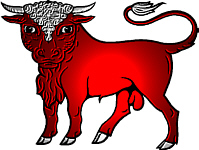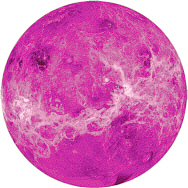 What we know about the Great Age of Taurus indicates that, true to the sign's definition, many great
builders lived during that Age, and left upon their landscape, as long-lasting and stable monuments, massive pyramids a
What we know about the Great Age of Taurus indicates that, true to the sign's definition, many great
builders lived during that Age, and left upon their landscape, as long-lasting and stable monuments, massive pyramids a t
some
locations, and giant megalithic rock formations at other areas. The
emphasis is
on 'builders' and their engineering accomplishments, as the fixed
Earth-sign of Taurus relates to the Earth – as substance from
the Earth is constructed upon the Earth in such a remarkably solid
form, demonstrating great endurance in spite of the damaging blasts
from sand and wind over time. By characterization, the sign of Taurus
represents durability, stableness, stubborn persistence, determination,
and practicality. No known construction from any other Age has
out-lasted the building accomplishments of these Taurus builders. The
enormous Ark
that Noah built was from this Great Age of Taurus, and perhaps it still
survives somewhere. t
some
locations, and giant megalithic rock formations at other areas. The
emphasis is
on 'builders' and their engineering accomplishments, as the fixed
Earth-sign of Taurus relates to the Earth – as substance from
the Earth is constructed upon the Earth in such a remarkably solid
form, demonstrating great endurance in spite of the damaging blasts
from sand and wind over time. By characterization, the sign of Taurus
represents durability, stableness, stubborn persistence, determination,
and practicality. No known construction from any other Age has
out-lasted the building accomplishments of these Taurus builders. The
enormous Ark
that Noah built was from this Great Age of Taurus, and perhaps it still
survives somewhere.
In addition to these phenomenonal builders, were the agriculturists and horticulturists of the Age. The growing and harvesting of several various herbs, grains, fruits, and
vineyards, were produced abundantly along the Nile River,
and several hybrid crops and plants are still in use today. Joseph, i.e. Imhotep,
second in command during Egypt's seven years of plenty, followed by seven years
of famine, lived during the Age of Taurus, and is again reflecting agriculture and a great builder.
“It is certain however that now they gather in fruit
from the earth with less labour than any other men and also with less than the
other Egyptians; for they have no labour in breaking up furrows with a plough
nor in hoeing nor in any other of those labours which other men have about a
crop; but when the river has come up of itself and watered their fields and
after watering has left them again, then each man sows his own field and turns
into it swine, and when he has trodden the seed into the ground by means of the
swine, after that he waits for the harvest, and when he has threshed the corn
by means of the swine, then he gathers it in”.
Herodotus, Histories II
Project Gutenberg
The Great Flood
took place during this Great Age of Taurus - vividly portrayed in Biblical
scripture and noted in other historical accounts as well. Because of the expected Flood, ‘Noah’, was instructed to build the giant Ark. Why a great flood in an Earth sign, you might ask?
Because the opposing sign of each Great Age also reflects its pattern into the Age
at hand in one way or the other as well, and the water sign of Scorpio is the
opposing sign to Taurus. As in all Ages, both signs - that immediate and the opposing,
produce embedded characteristics in the lives and events of the times that exist
under its umbrella, as noted in historical accounts for each particular Great
Age.
 The sign of Taurus is a feminine sign ruled by the
planet Venus, reflected in much Goddess worship throughout that Age. In The sign of Taurus is a feminine sign ruled by the
planet Venus, reflected in much Goddess worship throughout that Age. In Greek
legends it was the goddess Aphrodite, the goddess of love, beauty, and sexual
rapture. The goddess 'Venus' was the Roman goddess of love and beauty named
for the planet with the same name. The Roman Ceres, goddess of horticulture,
plants and agriculture, again reflects the Age of the earth sign, Taurus. The
Egyptian goddess Isis also portrayed the planet Venus as the Queen of the
Heavens. Isis was often seen with a throne atop her headdress to symbolize the
feminine side of the royal seats of gods, however artwork of Isis
with a solar disk between great horns [see depiction above], was more predominant.
The Semitic goddess, Astarte, or Ashtoreth, symbolized Venus, represented as a
young woman with cow's horns atop her head. Greek
legends it was the goddess Aphrodite, the goddess of love, beauty, and sexual
rapture. The goddess 'Venus' was the Roman goddess of love and beauty named
for the planet with the same name. The Roman Ceres, goddess of horticulture,
plants and agriculture, again reflects the Age of the earth sign, Taurus. The
Egyptian goddess Isis also portrayed the planet Venus as the Queen of the
Heavens. Isis was often seen with a throne atop her headdress to symbolize the
feminine side of the royal seats of gods, however artwork of Isis
with a solar disk between great horns [see depiction above], was more predominant.
The Semitic goddess, Astarte, or Ashtoreth, symbolized Venus, represented as a
young woman with cow's horns atop her head.
The symbolic animal for the Age of Taurus was, and is, the Bull, just
as Astrology has portrayed this sign's symbol for eons of time. Why
does a big red bull represent a feminine Earth sign? Because the symbol
came before the Age. Venus is the planet ruling the sign and Age of
Taurus, and Venus is a feminine planet on all accounts. Somehow the
Taurus bull is linked to the Egyptian god, Ptah; BUT the
red heifer that produced this venerated bull, was originally thought to
be the
goddess Isis. Could it actually be Isis,
not
the red heifer, of which the Jews long await – perhaps they have a
lapse of memory of
its true meaning? All types of bovine creatures were sacred, and in
some religions such as the Jewish relegion, sacrificed, during this Age
- bulls,
heifers, and their calves. The wearing of cattle horns in ancient Egypt implied
great power as ruler and prince – and even portrayed a god or goddess.
"When was the Most
Recent Age of Taurus? The Vernal Equinox Point could be seen against the
constellation of Taurus in about 4525 BCE, and left Taurus to move into
the constellation of Aries in about 1875 BCE, using modern constellation
boundaries. We have no choice [but] to use
modern boundaries, because constellation boundaries were not defined by
Babylonian astrologers until more than a thousand years after the Vernal
Equinox Point passed out of what we call the constellation of Taurus." Dr.
Shepherd Simpson
TABLE SHOWING WHAT OCCURRED DURING THE GREAT AGE OF TAURUS
Taurus is a fixed Earth sign and will reflect things pertaining to
Agriculture, the Bull, gifts of Mother Earth, goddess worship, the golden
calf, cattle worship, a red heifer, builders of enduring construction including; the great Pyramids,
'Noah's Ark', and the stone megaliths known as dolmen.
The Great Flood occurred during the
Age of Taurus - seen astrologically in the opposing water sign of Scorpio. |
Egyptian 'Horus' was known as the Bull of Heaven. A white Bull was
sacrificed in Babylonia every new year
celebrating Ramman. A red heifer is part of Jewish history.
The Bull cult can be seen in Assyria,
Egypt, Babylon, Crete,
and early Hebrew worship and symbolism. |
- 3102 BCE - Narmer, Egyptian Pharaoh born.
- ca. 3100 BCE – First stage in the construction of Stonehenge
- 3000 BCE – Narmer unifies Upper and Lower Egypt,
new capital erected at Memphis.
- 3000 BCE – Narmer, Pharaoh, died.
|
- 3114 BCE — Starting date of current 'Long Count'
in Maya calendar
- 3102 BCE — Year '0' of the Kali Yuga begins 18
February
|
The Jewish calendar began during the Age of Taurus in the year 3760 BCE. [See other notable events
in table above].
The ancient Egyptian civilization began during the Age
of Taurus, and represents that Age quite well. The Earth took a
direct hit from a comet in 3150 BCE, which impacted the eastern region of
the Mediterranean Sea, supposedly causing the
Great Flood. Large volcanoes erupted, a seven-year drought took place,
as well as many other natural disasters - all recorded in the legends of
ancient Sumer, Egypt, Babylon, and Biblical accounts.
Generally, the Eagle symbolizes Taurus’s opposing
water sign of Scorpio in today's modern times, but historically, the Egyptian Phoenix portrayed the sign of Scorpio rising from the ashes. Also a
Snake is often seen in Egyptian art and historical accounts, depicting the Age
of Taurus, but the snake was actually representing the opposing water sign of
Scorpio.
By all accounts, ancient Egypt most
definitely, was the ‘country’ and the ‘people’ representing the Great Age of
Taurus. The official ending of the Age of Taurus occurred when the Israelites
made their Exodus out of Egypt
– this would have then ushered in the Great Age of Aries – and its war-god,
YHWH, representing Mars [Marduk].
Back
|

 2006
2006

 2006
2006
 What we know about the Great Age of Taurus indicates that, true to the sign's definition, many great
builders lived during that Age, and left upon their landscape, as long-lasting and stable monuments, massive pyramids a
What we know about the Great Age of Taurus indicates that, true to the sign's definition, many great
builders lived during that Age, and left upon their landscape, as long-lasting and stable monuments, massive pyramids a t
some
locations, and giant megalithic rock formations at other areas. The
emphasis is
on 'builders' and their engineering accomplishments, as the fixed
Earth-sign of Taurus relates to the Earth – as substance from
the Earth is constructed upon the Earth in such a remarkably solid
form, demonstrating great endurance in spite of the damaging blasts
from sand and wind over time. By characterization, the sign of Taurus
represents durability, stableness, stubborn persistence, determination,
and practicality. No known construction from any other Age has
out-lasted the building accomplishments of these Taurus builders. The
enormous
t
some
locations, and giant megalithic rock formations at other areas. The
emphasis is
on 'builders' and their engineering accomplishments, as the fixed
Earth-sign of Taurus relates to the Earth – as substance from
the Earth is constructed upon the Earth in such a remarkably solid
form, demonstrating great endurance in spite of the damaging blasts
from sand and wind over time. By characterization, the sign of Taurus
represents durability, stableness, stubborn persistence, determination,
and practicality. No known construction from any other Age has
out-lasted the building accomplishments of these Taurus builders. The
enormous